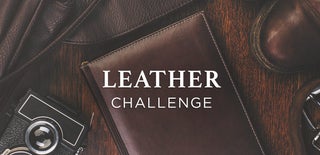Introduction: Leather Sheaths for Small Articles
I have a lot of scraps of veg tanned leather, and I'm always looking for ways to use them. I like working with this type of leather because it can be stretched and shaped to fit snugly around tools and things. Lately I've been making these little leather sheaths to protect various small articles like pocket knives, whetstones, harmonicas, and such.
You will need some scraps of veg tanned leather, a sharp knife and cutting mat, an awl (or two), some binder clips, strong thread, dull needles (for saddle stitching), and enough plastic wrap to wrap around the article you will be making a sheath for.
Step 1: Form the Leather to Fit, and Clamp to Hold the Shape
Pick a leather scrap large enough to wrap around the item you want to protect, and decide where you want to make the seam(s). Don't worry about cutting it to shape yet. For now, you're going to work the dampened leather to fit the shape of the article you are covering. Once you get the shape to hold, you will trim the edges back enough to fit binder clips on the seams to hold the shape. You should first wrap the item you are making the sheath for in plastic wrap, to avoid staining the leather, or the item.
There is an ideal level of moisture that allows veg tanned leather to be stretched and formed, where it will more or less hold its shape. I usually wet the leather on both sides and work it a bit to make sure the moisture gets to the inner layers. Then let it dry for a while, at least till the surface gets lighter colored and it feels like it will hold a shape. You will get a feel for it.
When the leather is ready to cooperate, wrap the leather around the item, and bring the edges together tightly, stretching and working the leather to fit the shape of the item. Once it will more or less hold the shape, mark a line about a finger-tip's width from where the edges pinch together. Trim both sides of the leather along this line, and use binder-clips to hold the edges together tightly. Some binder clips can stain wet leather, so I'm using little strips of cardboard between the leather and the binder clip, if that kind of thing doesn't bother you, feel free to skip the cardboard.
I let this piece dry overnight, but if you're in a hurry, you could move to the next step after a couple of hours of drying.
Step 2: Trim and Stitch
The leather is holding it's shape, and it's time to trim it down and figure out where to make the seams. Leave the item wrapped in plastic, for now, as you will do another round of wet-forming for the final fitting.
I could have done flat seams here, but I decided to wrap the front around the back edge, and make the stitches go straight through to the inside. To make that work, I needed to trim part of the edge off the front seam. Also, I probably should have left myself a little bit more leather for this seam, as the fit was a little tight.
I used the awl to pierce through both sides of the leather, and then used a stitching needle through the holes to hold it in place while I made another set of holes. If you look closely at the pictures, you will see how the needle is attached to the thread by poking it back through the thread after threading the needle. Just keep working along the seam, adding holes with the awl as you sew along behind. This harmonica sheath only took a few stitches for each side.
If you're making a flat seam, just make a line of stitches straight through the front and back faces, close to the item you are covering. Trim the leather close to the stitching, once it's dry.
When you have completed stitching at both ends, make sure the item will slide in and out of the sheath. It will probably seem tight at first, but this is easy to fix. While the leather is still a bit damp (or re-dampen it a little), wrap more layers of plastic wrap around your article (or you can cut strips of plastic, like from a milk carton, and slide them in along side the article). The added plastic will stretch the leather enough so that when it's dry the item will slide in and out easily.
A note on trimming: If you're making a sleeve that you'll have to slide narrow articles out of, it would be a good idea to leave a "tab" to hold onto, at the opposite end from the opening.
Step 3: Trim the Flap and Make It Secure
This sheath is going to have a flap, so I decided to make a tiny slot to slide the tab-end of the flap into to keep it closed. In the pictures, you can see how the outline of the flap is just sketched onto the leather and then trimmed to make the little tab. It isn't fancy, but it does keep the flap closed.
After all the stitching and trimming was done, I dampened the leather one last time and put the harmonica back inside to do the final shaping of the leather. I just squeeze and smooth the leather while it's drying, so it fits the shape snugly. This will get a better shape and fit after it's been carried in a pocket for a while.
The last photo shows a selection of other small articles that I made sheaths for. I picked up these Novaculite whetstones for nickles at a yard-sale. When I found out how much they go for, I decided to protect them. They are expensive and they break easily if you drop them.

Participated in the
Leather Challenge











